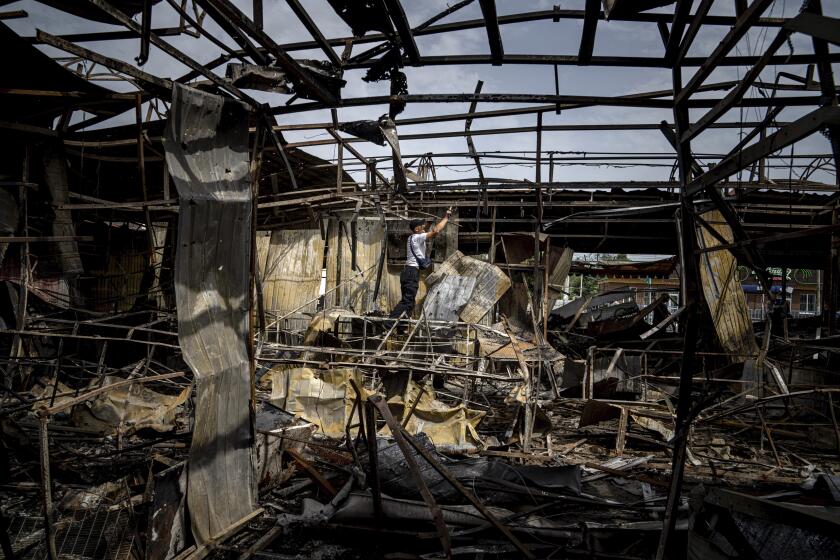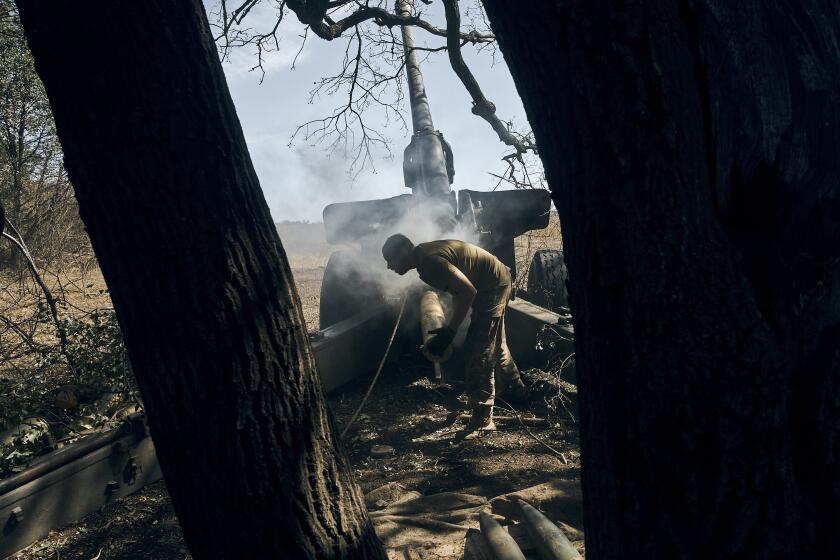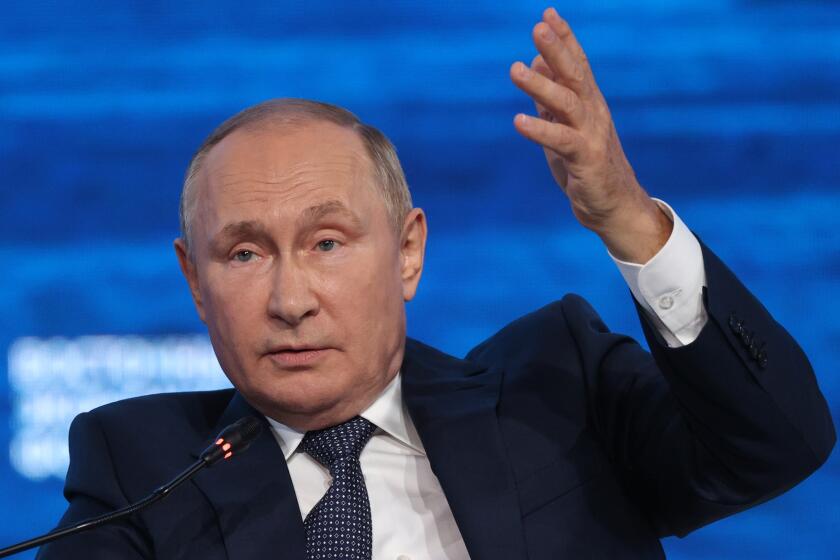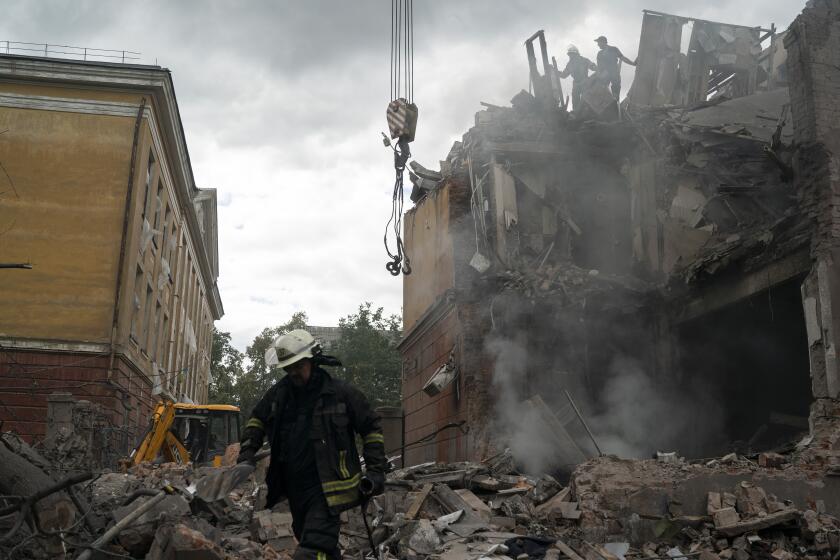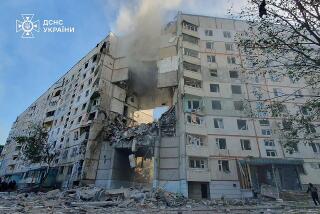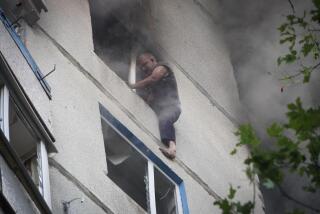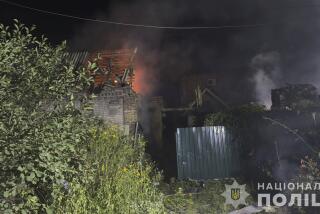Ukraine takes back some territory in Kharkiv area as nuclear plant remains in peril
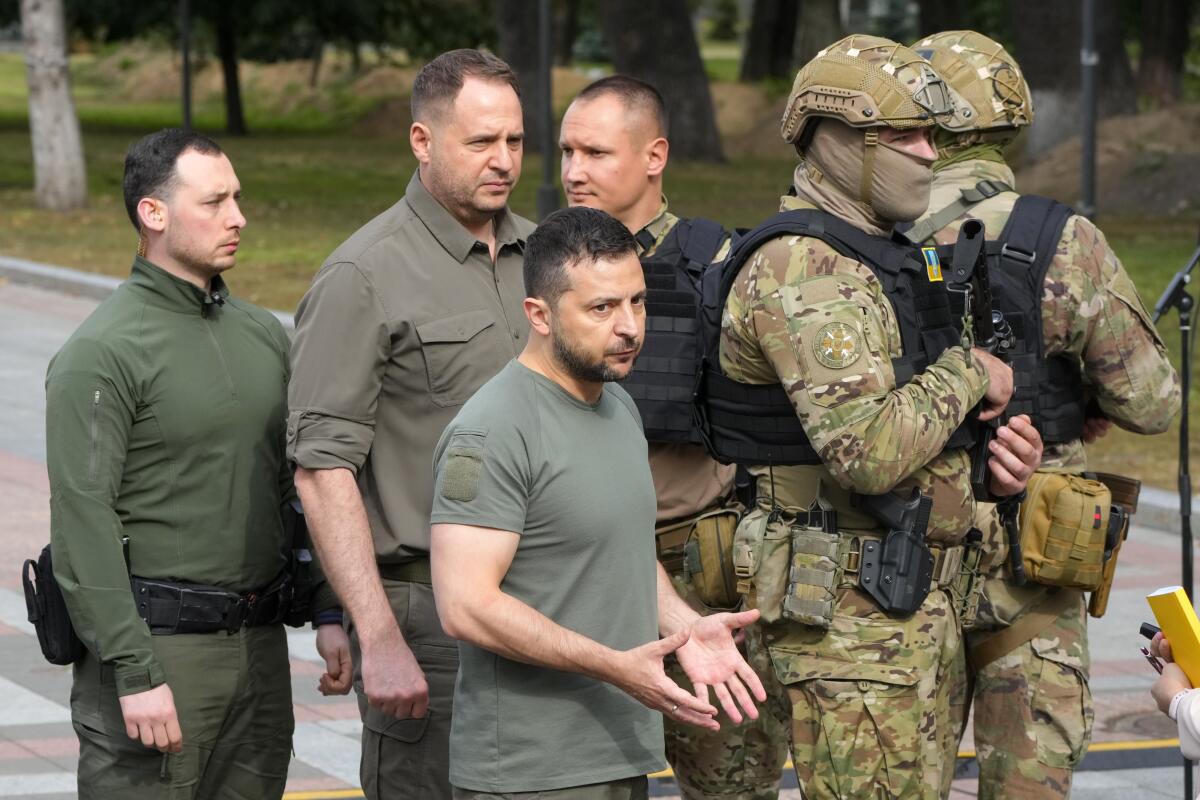
- Share via
KYIV, Ukraine — Ukrainian forces on Friday claimed new success in their counteroffensive against Russian forces in the country’s east, taking control of a sizable village and pushing toward an important transport junction. The United States’ top diplomat and the head of NATO noted the advances, but cautioned that the war is likely to drag on for months.
Ukrainian President Volodymyr Zelensky commended the military for its gains, saying in his nightly video address that Ukrainian troops have reclaimed more than 30 settlements in the Kharkiv region since the start of the counteroffensive there this week.
“We are gradually taking control over more settlements, returning the Ukrainian flag and protection for our people,” Zelensky said.
Ukraine’s military said it also launched new attacks on Russian pontoon bridges used to bring supplies across the Dnieper River to Kherson, one of the largest Russian-occupied cities, and the adjacent region in the south. Ukrainian artillery and rocket strikes have left all regular bridges across the river unusable, the military’s southern command said.
Anxiety increased about Europe’s largest nuclear power plant, which was operating in emergency mode Friday for the fifth straight day due to fighting in the area.
That prompted the head of the U.N. atomic watchdog to call for the immediate establishment of a safety zone around the plant to prevent a nuclear accident.
Ukrainian authorities began distributing iodine tablets to residents near the Zaporizhzhia nuclear plant amid fears that fighting nearby could trigger a catastrophe.
The Zaporizhzhia nuclear power plant came under the control of Russian forces early in the war but is being operated by Ukrainian staff. The plant and surrounding areas have been repeatedly hit by shelling that Russia and Ukraine blame on each other’s forces.
The last power line connecting the plant to the Ukrainian electricity grid was cut Monday, leaving the plant without an outside source of electricity. It is receiving power for its safety systems from the only reactor — out of six total — that remains operational.
In other advances, the Ukrainian military said it took control of the village of Volokhiv Yar in the Kharkiv region and aimed to advance toward the town of Kupiansk, which would cut off Russian forces from key supply routes.
The International Atomic Energy Agency urges Russia and Ukraine to establish a demilitarized zone around the Zaporizhzhia nuclear power plant to avoid a Chernobyl-like disaster.
Pro-Russian authorities in the Kupiansk district said civilians were being evacuated toward the Russian-held region of Luhansk.
“The initial signs are positive and we see Ukraine making real, demonstrable progress in a deliberate way,” U.S. Secretary of State Antony J. Blinken said in Brussels, a day after visiting Kyiv, Ukraine’s capital.
“But this is likely to go on for some significant period of time,” he said. “There are a huge number of Russian forces in Ukraine and unfortunately, tragically, horrifically, President [Vladimir] Putin has demonstrated that he will throw a lot of people into this at huge cost to Russia.”
Russian President Vladimir Putin says Moscow has resisted the ‘economic, financial and technological aggression’ of the West’s sanctions over Ukraine.
NATO Secretary-General Jens Stoltenberg, who met with Blinken, said the war is “entering a critical phase.”
The gains “are modest and only the first successes of the counteroffensive of the Ukrainian army, but they are important both in terms of seizing the military initiative and raising the spirit of Ukrainian soldiers,” said Mykola Sunhurovskyi, a military analyst at the Razumkov Center in Kyiv.
Energoatom, the state nuclear operator, said Friday that repairs to the electric lines at the Zaporizhzhia plant are impossible because of the shelling and that operating in the area carries “the risk of violating radiation- and fire-safety standards.”
“Only the withdrawal of the Russians from the plant and the creation of a security zone around it can normalize the situation at the Zaporizhzhia NPP. Only then will the world be able to exhale,” Petro Kotin, the head of Energoatom, said Friday on Ukrainian TV.
The Biden administration will provide $2 billion in long-term foreign military financing to Ukraine and 18 of its neighbors, including NATO members.
Earlier, Kotin said the plant’s only operating reactor “can be stopped completely” at any moment, and as a consequence the only power source would be a diesel generator.
There are 20 generators on site and enough diesel fuel for 10 days. After that, about 200 tons of diesel fuel would be needed daily for the generators, which he said is “impossible” to get while the plant is occupied by Russian forces.
Rafael Mariano Grossi, the director of the International Atomic Energy Agency, said Friday that there was little likelihood of reestablishing reliable offsite power lines to the plant for the time being.
“This is an unsustainable situation and is becoming increasingly precarious,” Grossi said, calling for an “immediate cessation of all shelling in the entire area” and the establishment of a security zone.
After decades of neglect and the stigma of its Nazi past, Germany warms up to the idea of rebuilding its army, thanks to the war in Ukraine.
“This is the only way to ensure that we do not face a nuclear accident,” he said.
Fighting continued Friday elsewhere in Ukraine.
Russian planes bombed the hospital in the town of Velyka Pysarivka, on the border with Russia, said Dmytro Zhyvytskyi, governor of the Sumy region.
He said that the building was destroyed and that there were an unknown number of casualties.
In the Donetsk region in the east — one of two that Russia declared to be sovereign states at the outset of the war — eight people were killed in the city of Bakhmut in the last day, and the city is without water and electricity for the fourth consecutive day, Gov. Pavlo Kyrylenko said.
Four people were killed in shelling in the Kharkiv region, two of them in Kharkiv city, Ukraine’s second-largest, according to regional Gov. Oleh Sinegubov.
The shelling of the city continued Friday afternoon, Mayor Ihor Terekhov said, wounding 10 people, including three children.
Among the settlements Ukraine has claimed to have regained in the Kharkiv region is the small city of Balakliya. Social media posts showed weeping and smiling Balakliya residents embracing Ukrainian soldiers.
Kremlin spokesman Dmitry Peskov on Friday refused to comment on Ukraine’s claims of having retaken Balakliya, directing all such questions to the Russian Defense Ministry.
But Vitaly Ganchev, the Russian-installed official in the Kharkiv region, confirmed Friday that “Balakliya, in effect, is not under our control.”
Ganchev said “tough battles” were continuing in the city.
Helicopters and fighter jets streaked over the rolling plains of the Donetsk region, with the jets heading toward Izyum, near where Ukrainian forces have been carrying out a counteroffensive. The jets fired flares and black smoke billowed in the distance.
More to Read
Sign up for Essential California
The most important California stories and recommendations in your inbox every morning.
You may occasionally receive promotional content from the Los Angeles Times.
